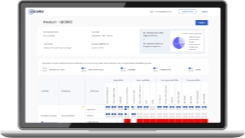
Every organization is unique, and so are its challenges. That’s why Training Needs Assessment (TNA) is a customizable process it adapts to the specific needs of your business and workforce.
Have you ever noticed growing stress within your organization? Maybe deadlines are being missed, team collaboration feels strained, or productivity seems to be slipping. When you dig deeper, you might discover the root cause: a lack of the right skills.
TNA dives into these gaps, evaluates your organization’s current capabilities, and identifies key areas where growth and improvement are needed. It provides the structure to address these challenges effectively.
Despite its importance, only 56% of organizations conduct a formal needs assessment, according to the Association for Talent Development (ATD). Yet, 68% of those who do find it highly effective in driving better performance and results. This highlights just how valuable TNA can be.
In this blog, we’ll explore the six vital components of TNA and how they work together to build a strong foundation for workforce development. Let’s dive in!
6 Vital Components of Training Needs Assessment
Companies that conduct a thorough training needs assessment are more likely to see a positive return on investment from their training programs. The reason? Training can be tailored to address specific gaps within an organization. This blog segment talks about the key components of a training needs assessment.

1. Identifying Stakeholder Requirements
Every training program needs a starting point, and in TNA, that’s understanding what your stakeholders need. Think of stakeholders as the key players team leaders, HR managers, department heads, and even employees who know where the gaps are.
Why does this matter? Because they have the clearest picture of what’s holding your organization back. HR might flag communication gaps, while department heads could highlight technical issues. Listening to their insights ensures your training programs target the right priorities.
For this reason, understanding stakeholders is the foundation of an effective TNA.
2. The Right Data Collection Methods for Accuracy
Once you’ve identified your stakeholders, the next step is gathering information because without the right data, you’re just guessing. But here’s the thing: not all data is created equal, and how you collect it matters.
Surveys and interviews? Great for understanding employee needs. Performance reviews? Perfect for spotting recurring issues. Observation? A goldmine for real-time insights. The key is using a mix of these methods to get a 360-degree view of your organization’s needs.
In TNA, collecting the right data is like building a map you can’t close skill gaps if you don’t know where they are.
3. Data Analysis
Data analysis is where everything starts to make sense. It’s the step that brings together all the information you’ve collected surveys, performance reviews, and focus group insights and uncovers patterns, trends, and gaps that need attention.
For example, if employees are missing deadlines, analysis can reveal the real issue. Is it a lack of project management skills? Or maybe the tools they’re using aren’t efficient enough. Similarly, performance metrics might highlight recurring struggles in certain departments, pointing to specific technical skill gaps.
The power of data analysis lies in finding both the "what" and the "why." Modern tools like dashboards and HR analytics platforms can simplify the process, helping you focus on areas with the biggest potential for improvement.
By organizing scattered data into clear insights, data analysis gives you the direction you need to design impactful training initiatives.
4. Strategic Alignment with the Company's Goals
Training is most effective when it’s tied directly to the bigger picture your company’s goals. A Training Needs Assessment ensures that the skills you’re building in your employees aren’t just relevant but actively contributing to your organization’s success.
For example, if your company is focusing on digital transformation, the training should emphasize hard skills like data analysis, cybersecurity, or using digital tools. On the other hand, if improving customer experience is the priority, training programs should focus on soft skills like communication, empathy, and problem-solving.
When training aligns with your goals, it creates a win-win: employees grow in ways that help them succeed, and the organization gets closer to achieving its objectives. It’s not just about filling skill gaps it’s about making sure those skills drive meaningful results.
5. Development of Clear Objectives
Every successful training program starts with a clear destination. Without defined objectives, it’s impossible to measure success or track progress. That’s why creating clear, specific goals is a key part of the Training Needs Assessment.
Think of these objectives as a roadmap for both employees and the organization. If the goal is to improve it & technical skills, the objective might be: “Train all employees on the new project management tool within three months.”
Similarly, for leadership development, an objective could be: “Increase team leads’ ability to provide constructive feedback through workshops and role-playing exercises.”
Clear objectives give employees direction and purpose in their learning journey. They also make it easier for organizations to measure the impact of their training programs and ensure alignment with broader business goals.
6. Establishing Effective Evaluation and Feedback Processes
Training doesn’t end when the session is over it’s complete only when you know it worked. That’s where evaluation and feedback come in. This step is about measuring the impact of your training programs and using those insights to improve them further.
Feedback should be a two-way process. Employees share their experiences, while organizations assess the outcomes to ensure the training achieves its goals. This ongoing exchange helps identify what’s working, what needs adjustment, and how to keep the training relevant.
By building strong evaluation processes, you create a culture of continuous improvement. Every training initiative becomes an opportunity to learn, adapt, and deliver better results for both employees and the organization.
Purpose of Training Needs Assessment
Like any process, success can be increased by starting with a strong foundation. A training needs assessment establishes the foundation for determining what training your staff needs and how to best deliver it to them. It is an evaluation procedure businesses and other organizations use to ascertain the knowledge, skills, and talents that their workers must possess to meet performance standards. Three main areas are thought to be reliable indicators of those needs:
- Employees' skill level
- Frequency of skill usage by employees
- Employees’ skills aligned with the organization’s objectives
One training needs assessment result is a list of who needs what kind of training. For example, your organization may discover that the IT department is not keeping up with industry standards and requires training to broaden its understanding of the most recent technological advancements. In that case, you need to provide corporate IT training courses.
Strategic alignment and performance enhancement are the two main objectives of a training needs assessment. First, it allows businesses to match their training programs with their companies' overall aims and objectives. Second, it improves worker productivity and performance in general. The various components of a training needs assessment help cultivate a more competent workforce by empowering employees with the necessary knowledge and skills to thrive in their professions and recognizing and correcting areas of weakness.
Importance of TNA in Effective Training Program Development
Surveys highlight that most employees who desire to learn want to be trained. So, before developing a training program, it is essential to consider their preferences and conduct a training needs assessment. This highlights the importance of TNA in developing an effective training program. Analyzing the need for training serves as the bedrock upon which effective training programs are built, offering several crucial advantages instrumental in achieving organizational success.
Apart from enabling the organizations to pinpoint specific areas of skill gaps, a training needs assessment also facilitates alignment between training initiatives and broader business goals. Below are some points to emphasize TNA’s importance in developing an effective training program:

1. Accuracy and Pertinence
TNA ensures that training initiatives are focused and pertinent to the real requirements of staff members and the company, eschewing a universal strategy. Instead of using a one-size-fits-all approach, TNA carefully assesses the organization's specific needs and skill shortages, enabling customized training initiatives that target important areas for development.
Focusing on the resources where they are most required increases the effectiveness of the training and maximizes the use of the available resources. TNA helps create and implement pertinent training interventions that directly contribute to the development and success of staff members and the business. This is done by thoroughly analyzing job responsibilities, organizational objectives, and personnel competencies.
2. Cost-Effectiveness
The Training Needs Assessment process helps to determine specific training needs so that organizations can maximize the allocation of their resources. This guarantees that funds are allocated to developing important skills and cutting unnecessary spending on general programs. Targeted training increases employee proficiency and helps maximize efficiency and effectiveness by matching investments with strategic objectives.
3. Risk Mitigation
Filling skill gaps with targeted training reduces organizational risks like mistakes, inefficiencies, and noncompliance. Businesses lower risks and improve overall performance by strengthening staff competencies. This proactive strategy fosters a culture of excellence and regulatory conformance by developing a more capable and resilient staff.
4. Continual Improvement
An ongoing project essential to an organization's continual growth is the Training Needs Analysis (TNA). Companies can adjust training programs to changing demands and business landscapes. Frequent evaluations enable prompt modifications, guaranteeing that training stays aligned with corporate goals and adaptable to changing requirements. This iterative process encourages adaptability, durability, and continuous improvement of workers' abilities and output.
5. Alignment with Industry Trends
The Training Needs Analysis (TNA) is an essential tool for maintaining the relevance and currency of training programs in the face of swift changes in the corporate environment. TNA enables businesses to stay updated with new technology, market trends, and changing best practices by allowing continuous evaluations. This proactive strategy ensures that training programs adapt to the ever-changing environment and give workers the tools they need to successfully handle opportunities and challenges of the modern world, maintaining the competitiveness and agility of the firm.
The above-stated points further elevate the multifaceted benefits of conducting a Training Needs Assessment in driving effective training program development and organizational success.
Frequently Asked Questions
Conclusion
A clear roadmap for assessing training needs is vital for building a skilled and future-ready workforce. Training Needs Assessments (TNAs) help organizations identify gaps, refine training programs, and align workforce capabilities with business goals.
A powerful tool in this process is the Skill Matrix. By mapping existing skills against role requirements, it provides a clear view of where gaps lie and what areas need improvement. This not only bridges skill gaps but also ensures employees are better equipped to meet organizational demands, driving both personal and business growth.
At the heart of effective training is the ability to evolve with changing needs. As a leading corporate training company, Edstellar uses tools like the Skill Matrix to assess skills, address gaps, and design tailored development programs. With this approach, organizations can cultivate talent that’s ready to take on forthcoming challenges.
By combining TNAs with tools like the Skill Matrix, organizations can foster a culture of growth and continuous improvement, paving the way for sustained success.
Explore High-impact instructor-led training for your teams.
#On-site #Virtual #GroupTraining #Customized
Edstellar Training Catalog
Explore 2000+ industry ready instructor-led training programs.

Coaching that Unlocks Potential
Create dynamic leaders and cohesive teams. Learn more now!


Want to evaluate your team’s skill gaps?
Do a quick Skill gap analysis with Edstellar’s Free Skill Matrix tool

Stay informed on L&D best practices
Get periodic updates on learning and development industry trends, expert insights, success stories and innovative training practices from Edstellar.
.svg)
Featured Post
.webp)
Contact Us
Submit your Training Requirements below and We'll get in touch with you shortly.
.svg)



.svg)
.svg)
.svg)

.svg)

.svg)
.svg)
.svg)

